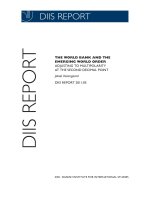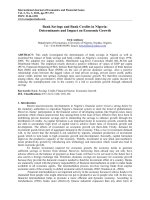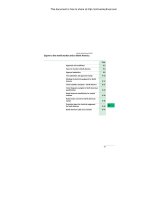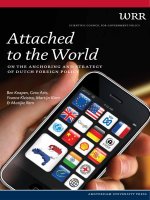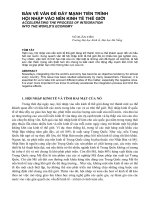Chinas integration to the world economy and impact on economic links with hong kong
Bạn đang xem bản rút gọn của tài liệu. Xem và tải ngay bản đầy đủ của tài liệu tại đây (861.43 KB, 144 trang )
CHINA’S INTEGRATION INTO THE WORLD ECONOMY
AND
IMPACT ON ECONOMIC LINKS WITH HONG KONG
LI JUN
NATIONAL UNIVERSITY OF SINGAPORE
2004
CHINA’S INTEGRATION INTO THE WORLD ECONOMY
AND
IMPACT ON ECONOMIC LINKS WITH HONG KONG
LI JUN
(B.ARTS, SHANDONG UNIVERSITY)
A THESIS SUBMITTED
FOR THE DEGREE OF MASTER OF SOCIAL SOCIENCES
DEPARTMENT OF ECONOMICS
NATIONAL UNIVERSITY OF SINGAPORE
2004
ACKNOWLEGEMENTS
I am in debt to my supervisor, Associate Professor Wong Chung Ming, for his
precious comments and suggestions given to the entire thesis, his patient and generous
guidance on my daily research. Without his help, I would not be able to complete my
study and finish the thesis at last.
I wish to express my gratitude to Dr. Jose Tongzon for his advice on research
topics and Dr. Zhang Zhao Yong who supplied me with the information on collecting
the data. I am also grateful to all those who have given me useful advices and
information during the period of my research.
The person whom I definitely should give my most thankful feeling is my dearest
mother. She has encouraged me to insist on completing my study even though she has
been seriously ill. Her love and courage is always my motive to do everything. I also
thank my father who has supported me on studying overseas all the time. I have
appreciated much Mr. Xu Yan’s generous help and care first midst and last.
Last but not least, I want to thank all my friends who have helped in one way or
another to make my life pleasant during the course of the preparation for the thesis.
i
TABLE OF CONTENTS
ACKNOWLEGEMENTS.................................................................................................. i
TABLE OF CONTENTS.................................................................................................. ii
LIST OF TABLES........................................................................................................... iv
LIST OF FIGURES ......................................................................................................... vi
SUMMARY...................................................................................................................viii
Chapter 1 Introduction ...................................................................................................... 1
Chapter 2 Trade Reform in China and Integration with Hong Kong ............................... 4
2.1 Trade Reform...................................................................................................... 5
2.2 Geographic & Commodity Composition of China’s Foreign Trade .................. 9
2.2.1 Geographical Distribution of China’s Foreign Trade ............................ 9
2.2.2 China’s Revealed Comparative Advantages and Its Exports Expansion
........................................................................................................................ 11
2.3 Trade Flows between China and Hong Kong................................................... 17
2.3.1 General Theory of Economic Integration.............................................. 19
2.3.2 Economic Integration Process in China and Hong Kong Economies... 21
2.4 Hong Kong-China Trade: Presence of Economic Integration .......................... 23
2.4.1 Methodology .......................................................................................... 28
2.4.2 The Main Results ................................................................................... 35
2.5 Conclusion ........................................................................................................ 51
Appendix 1.............................................................................................................. 53
Chapter 3 Foreign Investment in China and Hong Kong’s Contribution ....................... 56
3.1 The Evolution of Foreign Direct Investmet-Related Policies and Foreign
Investment Development in China .................................................................. 63
ii
3.2 Mainland Chinese Investment in Hong Kong................................................... 68
3.3 Hong Kong’s Investment in China ................................................................... 70
3.4 Regional Distribution of Foreign Direct Investment from Hong Kong to China
......................................................................................................................... 75
3.5 The Foreign Invested Enterprises in China....................................................... 84
3.6 Conclusion ........................................................................................................ 92
Chapter 4 The Development, Problems and Perspective of Guangdong – Hong Kong
Economic Link................................................................................................................ 95
4.1 Guangdong in the Context of Reform in China................................................ 96
4.2 Guangdong – Hong Kong Production Connection ......................................... 100
4.3 Developmental Problems in the Economic Linkage of Hong Kong and
Guangdong..................................................................................................... 104
4.4 Analysis of Future Developing Strategies of Guangdong and Hong Kong.... 107
Chapter 5 Concluding Remarks .................................................................................... 113
5.1 Main Conclusion of the Thesis ....................................................................... 113
5.2 Problems with the Development of China’s and Hong Kong’s Economy ..... 115
5.3 Prospects for China’s Economic Development and Hong Kong’s Role ........ 120
References..................................................................................................................... 127
iii
LIST OF TABLES
Table 2.1 Volume of Imports and Exports in China, 1978-2002 (US$ billion) ....... 5
Table 2.2 Geographical Distributions of China’s Exports and Imports, 1980, 1990,
and 2001 (%)................................................................................................... 10
Table 2.3 Revealed Comparative Advantage Indices (Exports), China and
Comparator, 1980-1996 .................................................................................. 13
Table 2.4 Changing Commodity Shares of Selected Labor-intensive Goods, 1980,
1990 and 1996 (%).......................................................................................... 13
Table 2.5 Growth Rate of Exports for Labor-Intensive Goods, 1978-1996 (%) .... 13
Table 2.6 The World’s Largest Bilateral Merchandise Trade Flows in Some
Individual Years (million US dollars) ............................................................ 18
Table 2.7 The Estimated Average Proportion of Outward Processing Trade in Total
Trade with China, 1989-2002 (%) .................................................................. 30
Table 2.8 The Estimated Proportion of Outward Processing Trade in Hong Kong –
China Total Trade, 1989-2002 (%)................................................................. 36
Table 2.9 An Intensity of Trade Analysis for Hong Kong-China Trade, 1980-2002
........................................................................................................................ 46
Table 3.1 Shares of Main Provinces and Municipalities of China in Realized Foreign
Direct Investment from Hong Kong, 1986-2001 (US$1,000) ........................ 81
Table 3.2 FDI Flows, Total Exports, and Exports by Foreign Invested Enterprises
(FIEs) in China, 1986-1999 (millions of US$) ............................................... 87
Table 3.3 Status of Registered Enterprises with Foreign Capital in China, 1986-2000
........................................................................................................................ 90
iv
Table 4.1 Shares of Guangdong & Shanghai in China’s GDP and Exports,
1978-2002 (%) ................................................................................................ 98
Table 4.2 Hong Kong's Imports from the Mainland Involving Outward Processing,
1989-2002 (US$ million).............................................................................. 101
v
LIST OF FIGURES
Figure 2.1 Comparison of Total Trade Value with Outward Processing Trade Value
for Hong Kong – China Trade, 1985-2002..................................................... 37
Figure 2.2 Unadjusted (Grubel-Lloyd) Index and Adjusted (Aquino) Index for Hong
Kong – China Intra-industry Trade in Domestic Outward Processing Trade,
1985-2002 ....................................................................................................... 41
Figure 2.3 Unadjusted (Grubel-Lloyd) Index and Adjusted (Aquino) Index for Hong
Kong – China Intra-industry Trade in Re-export Outward Processing Trade,
1985-2002 ....................................................................................................... 43
Figure 2.4 Intensity of Trade Index for Hong Kong – China Trade, 1980-2002.... 48
Figure 2.5 Trade Complementarity Index for Hong Kong – China Trade, 1980-2002
........................................................................................................................ 49
Figure 2.6 Country Bias (trade resistance) Index for Hong Kong – China Trade,
1980-2001 ....................................................................................................... 50
Figure 3.1 Total Investment in Fixed Assets in China by Source of Funds
(1981-2001) .................................................................................................... 57
Figure 3.2 Foreign Direct Investment in China by Country/Region, 1979-2001
(percent of total).............................................................................................. 62
Figure 3.3 The Share of Hong Kong’s Foreign Investment in China’s Contracted
Utilization and Actual Utilization of Foreign Capital (1986-2002) ............... 71
Figure 3.4 The Share of Hong Kong’s Foreign Direct Investment (FDI) in China’s
Contracted Utilization and Actual Utilization of Foreign Direct Investment
(1986-2002) .................................................................................................... 71
vi
Figure 3.5 Hong Kong’s Contribution to China’s Utilization of Foreign Investment
(1986-2002) .................................................................................................... 74
Figure 3.6 Shares of Realized FDI in Total Investment in Fixed Assets by Regions of
China, 1986-2001............................................................................................ 83
Figure 3.7 the Proportion of Realized FDI from Hong Kong in Total Realized FDI
Utilized by Regions in China, 1986-2001 ...................................................... 83
vii
SUMMARY
China opened its door to the outside in 1978, when it began the process of economic
integration into the world economy. A series of reforms in areas ranging from foreign
trade, foreign investment, taxation and finance, banking, foreign currency and price
control, to social welfare and housing, are being implemented. Among these, reforms
and achievements of trade and foreign investment are remarkable.
Trade liberalization is a key component of China’s overall economic reform and
modernization program. So far it has proceeded unilaterally and generated a huge
expansion of China’s role in world trade. China adopted the policies that can facilitate
the exports of labor-intensive products and export-oriented economy. Although the
regional distribution of China’s exports and imports has diversified around the world, it
still relies to certain extent on Hong Kong’s position. The revealed comparative
advantage index is applied to analyze the composition of commodity for exports and its
future changing pattern.
Inflows of foreign direct investment to China virtually nonexistent before 1979,
has poured at an accelerating speed since 1992. However, with more openness and more
liberalization, the uneven geographical distribution of foreign investment between the
east regions and the inner regions in China would be reinforced. A large amount of
investment from Hong Kong makes such regional inequality worse. Through the
investigation on the performance of foreign-invested enterprises, it is proved that
foreign-invested enterprises made great contribution to China’s export growth.
Hong Kong has played a strategic part in the process of connecting China with
the outside world. China's "Hong Kong connection" has been vital to the success of its
export drive. Hong Kong’s contribution to the development of China's exports goes
viii
much further. An important finding obtained from my analysis is that a large proportion
of the foreign direct investment to China has come from Hong Kong and been mostly
directed to export-oriented joint-ventures in the coastal provinces, Guangdong in
particular.
Hong Kong's involvement in export-oriented production in China is not just
limited to joint ventures. A tendency of economic integration between Hong Kong and
China in trade would be checked. The analysis of the outward processing trade
involving intra-industry trade between their economic links as well as the adoption of
the indices such as intensity of trade, complementarity and trade resistance can clearly
demonstrate that an intensive economic integration trend exists in the Hong Kong-China
link. It is worthy noticing that much of Guangdong's success with processing using
supplied or imported materials is based on partnerships with counterparts in Hong Kong.
The evidence suggests that the economies of Hong Kong and Guangdong are becoming
increasingly integrated with one another. Kinds of suitable and practicable development
strategies would be explored to strengthen such close relationship.
There is clearly an important opportunity to reinforce the pace of trade reform,
foreign capital absorption and linkup with Hong Kong through China’s accession to the
WTO. Starting from a position of near-autarky, China has been catching up rapidly with
other developing countries in integrating with the global economy. Increased integration
and openness have paid rich dividends in the way of faster economic growth. Still, there
is much room for progress.
ix
Chapter 1 Introduction
Since the economic reform, China’s progress in trade expansion and increase of foreign
capital inflows has been phenomenal. China’s trade strategy is an important factor
affecting trade growth. Total trade increased from US$20.64 billion in 1978 to
US$620.80 billion in 2002 with an average growth rate of 14.1 percent per annum.
Exports increased at an average annual rate of 16.1 percent and imports at an average
annual rate of 12.8 percent during this period. Such increasing expansion of China’s
foreign trade over time is one of the most remarkable features of the impact of the
reform programs. The economic reforms policy, developing strategy and trade system
perform deeply the economic interaction between China and the rest of world.
China’s growing integration with global capital markets is reflected in its large
shares in absorption of cross-border inflows from other countries. Foreign investment
especially foreign direct investment (FDI) is needed in financing the modernization of
China. China was actively channeling FDI into key areas essential to the long term
development of the national economy and integrated more into the outside. Total FDI
attracted in China from 1979 to 2001 reached US$393.6 billion. The recipient of foreign
capital and technology has enabled China to restructure the industries and develop
production expertise.
Hong Kong has played an indispensable role in China’s economic reform. Since
1993, Hong Kong-China trade became the world’s third largest bilateral trading
relationship. Hong Kong’s obvious advantage in trade liberalization supplies China with
a unique chance to open itself to the outside to develop the backward economy.
Similarly, Hong Kong’s investment heavily influences China’s utilization of foreign
investment on quantity, quality and regional distribution as well. It also gives the
1
impulse on China’s export rapid growth by foreign-invested enterprises in the Mainland.
In Guangdong-Hong Kong relationship, the long-term and stable cooperation is still the
focus and interest of both sides. The role of Hong Kong in relation to China has become
more significant.
China’s accession to the WTO marks the beginning of its full integration with the
world economy. Its entry represents a grand strategy to ease the burden of reform,
because commitment to deeper reform and liberalization associated with the entry will
not only boost efficiency, but also foreign investor confidence in Chinese economy at a
time when it is desperately needed.
The facts then make one ponder the reasons behind the success. Questions that
may rise are: how China could make outstanding progress in its external trade and
attracting foreign capital? What are the changes of trade flows, pattern and developing
strategy? What are the factors affecting the absorption of foreign investment,
distribution and utilization? How do Hong Kong and China shed light on a sort of
economic integration? What are the problems and prospects of further development
between China and Hong Kong in terms of trade and investment? Will Guangdong keep
close economic cooperation with Hong Kong? The effort of liberalization and
integration on economic reforms of China seems significant.
This thesis serves to clarify these doubts and to provide some insights on the
aspects of factors affecting trade liberalization and foreign capital absorption, and issues
of regional disparity and commodity composition change in trade growth and foreign
investment distribution and utilization. The finding of economic integration within the
China-Hong Kong linkage is made possible by computing certain indices and several
2
measures in their trade flows or by conducting empirical studies through analysis of the
impact of investment for Hong Kong. I propose some ideas for the future development
of Hong Kong-Guangdong relation.
It is hoped that this thesis will provide readers with a better understanding of the
processes and prospects of China’s liberalization on external trade and inward FDI,
especially its economic link with Hong Kong. Three goals of the thesis are as follows.
First, it provides a forum of academic research on China’s reforms in foreign trade and
foreign investment. Second, it makes clear the tendency of economic integration
between Hong Kong and China. Third, it may supply some good ways to discover and
resolve the problems occurring during the period of reforms.
The thesis is organized as follows: Chapter 1 offers general introduction. Chapter
2 studies trade reform and expansion in China, touching on the characters, problems and
suggestions of foreign trade. The economic integration with Hong Kong in trade will be
explored as well. What is of interest then is the development of foreign investment.
Thus Chapter 3 intends to find out the role of foreign capital in China’s economic
reforms. Hong Kong’s important function in driving foreign capital will be described in
this chapter. After that, particular issues such as certain area in China that has a very
intensive economic relation with Hong Kong are to be probed in Chapter 4. And
Chapter 5 goes on to do the conclusion and prospects for China’s economic
development and linkup with Hong Kong.
3
Chapter 2 Trade Reform in China and Integration with
Hong Kong
Economic reform and the opening up of the economy to the outside world in the past
twenty-six years (1978-2002) have been marked by an extraordinary expansion of
foreign trade in China. Total trade increased from US$20.64 billion in 1978 to
US$620.80 billion in 2002 with an average growth rate of 14.1 percent per annum.
Exports increased at an average annual rate of 16.1 percent and imports at an average
annual rate of 12.8 percent during this period. Trade structure continued to shift in favor
of manufactured commodities. The share of manufactures in total exports increased to
89 percent in 2001 from 49.7 percent in 1980. The geographic distribution of China’s
foreign trade has been diversified. China has become the largest recipient of foreign
capital among the developing countries in recent years and became world’s fourth
largest trading nation in 2002, rising from twenty-ninth in 1978. Official foreign
exchange reserves increased from US$0.8 billion in 1979 to US$212 billion in 2001. It
should be noted that the degree of openness of Chinese economy, reflected in the share
of foreign trade in GDP, has been higher and higher since 1978. From Table 2.1, the
rapid growth of total trade and balance of trade can be distinguished. In brief, following
the economic opening up in the 1980s and 1990s, the Chinese economy has been deeply
interacted with other economies outside. It is to be hoped that China will open up wider
and faster by further opening its market and increasing transparency to implement its
commitments in the WTO. That will entail integration of China’s economy with the
world economy and bring China’s foreign trade system in line with international
practice.
4
Table 2.1 Volume of Imports and Exports in China, 1978-2002 (US$ billion)
Year
Total
Exports
Imports
Balance
1978
1980
1985
1986
1987
1988
1989
1990
1991
1992
1993
1994
1995
1996
1997
1998
1999
2000
2001
2002
20.64
38.14
69.60
73.85
82.65
102.78
111.68
115.44
135.63
165.53
195.70
236.62
280.85
289.90
325.16
323.95
360.63
474.29
509.65
620.80
9.75
18.12
27.35
30.94
39.44
47.52
52.54
62.09
71.84
84.94
91.74
121.01
148.77
151.07
182.79
183.71
194.93
249.20
266.10
325.60
10.89
20.02
42.25
42.90
43.22
55.27
59.14
53.35
63.79
80.59
103.96
115.61
132.08
138.83
142.37
140.24
165.70
225.09
243.55
295.20
-1.14
-1.90
-14.90
-11.96
-3.78
-7.75
-6.60
8.74
8.05
4.35
-12.22
5.40
16.69
12.24
40.42
43.47
29.23
24.11
22.55
30.40
Trade/GDP(%)
10.7
13.5
23.2
25.70
26.10
26.10
25.30
29.70
32.70
33.80
30.50
41.30
38.40
33.40
36.10
32.80
36.06
43.92
43.97
50.47
Source: China Statistical Yearbook, various issues.
2.1 Trade Reform
A key to understand the rapid expansion of foreign trade in China is policy reform and
trade liberalization within a broad discipline for economic restructuring. Trade
liberalization can be defined as a process involving three elements (Greenaway and
Sapsford, 1994): a reduction in import barriers with no change in export incentives; a
movement of relative prices towards neutrality via a reduction in import barriers and/or
an improvement in export incentives; and the substitution of less costly instruments for
more costly instruments of protection, such as tariff or quotas. China has made progress
in all three areas in the past over twenty years, as documented in Harding (1987), Hsu
(1989), Lardy (1992), Wang (1993), Zhang (1993) and Li (1997).
China is the largest developing economy to embark on a strategy of trade
liberalization. The results appear to be nothing short of spectacular as shown in Table
2.1. In the first ten years of economic opening-up, China’s trade jumped sharply from
5
merely over US$20 billion in 1978 to over US$110 billion in early 1990s. China’s role
in the world economy grew significantly during this decade of rapid trade growth.
These great achievements obviously could not be made possibly through the traditional
rigid foreign trade system.
The entire development of China's policies of foreign trade is an outcome of the
influence of both Marxian and conventional western economic thought (Zhao, 1991).
As the general designer of China’s future economic development, Deng Xiaoping
created his own theory combining communism thought with other western theories
according to China’s real situation. As he proposed a major transformation of China’s
foreign trade and investment policies in the mid 1970s, Deng advocated a rapid
acceleration of exports, concentration on industrial and mining products1. The State
Council, China’s highest executive institution, promulgated a series of reform which
over the decade of the 1980s began to erode the bias against exports inherent in China’s
traditional trade policy and began to conform China’s foreign trade system to standard
international rules. These policy reforms included a decentralization of foreign trading
authority; the introduction of new forms of trade – primarily as means of promoting
exports – exports processing and compensation trade; the adoption of import and export
licensing to control the volume and commodity composition of trade, which was
regarded as a transition to liberalization of an import substitution trade regime (Krueger,
1978); a reduction in the degree to which the official exchange rate overvalued the
domestic currency and a reduction in direct import subsides. The latter two measures
tended to bring the price of imports more in line with their true economic cost.
Devaluation, the rebate of various domestic taxes on exports goods, and a relaxation of
1
The text of Deng’s report, entitled “Some Problems in Accelerating Industrial Development,” was
translated in Chi Hsin (1977, 239-76).
6
the state’s monopoly control over the allocation of foreign exchange reduced the bias
against exports of the traditional foreign trade system.
In addition to the policies already mentioned above, China adopted several other
export promotion measures that were commonly observed in the early stages of trade
liberalization in developing countries. These included special programs of enhanced
exports credits; preferential interest rates on domestic currency loans to firms producing
for exports; subsidized domestic transport, storage, and insurance of export goods (Li,
1989) and the development of manufacturing facilities devoted exclusively to export
production. However, these export promotion programs appear to be in violation of the
GATT (the WTO former) Code on Subsidies and Countervailing Duties (1979)1 to
some extent.
The decade of the 1980s was one of far-reaching reforms of China’s foreign trade
system. Much of traditional structure was profoundly changed. China has instituted
extensive reforms to its foreign trade policies since the 1990s. Its openness on trade
policy was above the average for all large developing countries in the early 1990s
actually. Trading system reforms have unfolded in a progressive manner.
On 1 July 1994 China promulgated its Foreign Trade Law, which was formulated
to unify national foreign trade behavior and regulations and enhanced the transparency
of China’s foreign trade legal framework. Since 1990 the government has further
deregulated foreign trade franchise management, as a result, more local enterprises have
obtained the authority to conduct foreign trade. Between 1991 and 1993, with all the
export subsidies and most of import subsidies lifted by the central government, a range
of state-owned foreign trade enterprises were forced to be responsible for their own
profits and losses. In 1994, the government cancelled the mandatory plans and targets
1
Agreement on Interpretation and Application of Article VI, XVI, and XXIII of the General Agreement on
Tariffs and Trade, Geneva: GATT
7
for foreign exchange to be turned in to the central government. Foreign trade companies
could operate like other enterprises by paying taxes to the government. In the reform of
import and export control system, imported commodities were catalogued in 1992
instead of listing import substitution commodities in detail. New policies on the
management of imported commodities were published. Since 1994 the State has issued
invitation to tender for export quotas in selected commodities with the aim of
standardizing quota management, introducing fair competition, curbing subjective
decision making and increasing efficiency. At the same time, China was switching from
direct government control to legal and economic leverage in its management of foreign
trade by drafting related regulations. By the early 1990s China’s average tariff rate –
47.2 percent – had been among the highest in the world. Since 1990, China has
unilaterally slashed its tariffs on a number of occasions. In 1992 the overall tariff rate
was cut down to 39.9 percent and it dropped to 23 percent in 1996. Till 2001, the entire
tariff level was reduced to 14 percent, which is the average rate of the developing
countries. Non-tariff barriers categories covered almost a third of China’s imports in
1996, down from more than half in 1992. The system of government examination and
approval was abolished at the end of twentith century. By January 2005 China promises
to eliminate non-tariff measures which were applied to more than 400 products in 2001.
These figures indicate that China has committed itself to further trade liberalization and
offer to reduce tariffs and eliminate most non-tariff barriers under the provision of the
WTO agreement. Before the mid-1980s, China maintained rigid control over foreign
exchange. In late 1980s foreign exchange regulation markets were established. To
foreign trade companies, they were allowed to retain a portion of their foreign exchange
earnings for their own use and trade in foreign exchange on the market since 1990. The
government allowed foreign-invested enterprises to participate directly in the settlement
8
and sale of foreign exchange by banks. On January 1994 the official rate for the Chinese
Yuan was merged with the market rate and the Yuan became convertible under the
current account. Recently, China promise to adjust its currency – renminbi – to the more
flexible exchange system step by step. It is paving the way for the full introduction of
the market mechanism into the foreign exchange control system.
China’s foreign trade has developed very rapidly in the recent years with its
gradual reforms on trade policies and institutions. Deepened domestic reform, continued
trade liberalization and its accession to the WTO offer China a guarantee to fulfill the
tasks in the further reform. The integration of the Chinese economy into the region and
the global economy is beneficial for both China and its trading partners.
2.2 Geographic & Commodity Composition of China’s Foreign Trade
As studied on several multi-countries cases by Harrigan and Mosley (1991) and
Papageorgiou, Michaely and Choksi (1992), a support for view that trade liberalization
and trade expansion are related is offered. Liberalization reduces anti-export bias and
thus provides a conductive setting for export expansion, which is the main proposition
behind their studies. To China, the anti-export bias reduction has been achieved through
a series of comprehensive reform programs and trade policies aimed at eliminating
distortions due to the high degree of government restriction on trading activities. The
effort of trade liberalization on trade patters of China will be discussed below.
2.2.1 Geographical Distribution of China’s Foreign Trade
The regional distribution of China’s foreign trade around the world diversified
significantly during the period 1980-2001, particularly in relations to Hong Kong,
European Community (EC) and North America (Table 2.2).
9
Table 2.2 Geographical Distributions of China’s Exports and Imports, 1980, 1990, and
2001 (%)
Export
Import
1980
1990
2001
1980
1990
2001
ASEAN (excl. Singapore)
3.9
2.9
1.8
2.3
4.2
5.5
East Asia (excl. China)
47.7
64.5
39.0
31.2
49.0
28.2
Japan
20.1
14.6
13.6
25.2
14.7
15.8
NIEs
23.7
46.9
20.6
3.7
30.1
15.9
Hong Kong
19.7
36.8
43.3
6.3
24.7
36.6
Australia
1.1
0.7
3.3
5.2
2.6
7.6
EC
11.8
9.5
13.5
13.8
16.2
15.4
NAFTA
5.7
9.3
12.2
23.1
15.7
10.8
Others
33.7
16.0
14.1
29.8
16.6
18.5
Source: Calculations based on data from Direction of Trade, International Monetary Fund, Washington, D.C, 1991; International
Trade Statistics, World Trade Organization, 2002
China’s exports shares with Hong Kong has increased in the past twenty years,
growing from 19.7 percent in 1980 to 43.3 percent in 2001, while its import shares
increased from 6.3 percent to 36.6 percent during the same period. A picture of Hong
Kong’s shares in total Chinese trade is clearly sketched from Table 2.2, Hong Kong is
the only partner having the continuous increasing shares of exports and imports of
Chinese products from 1980 to 2001 although during the twenty years, there might exist
some individual years with slight fall or drop-off. Especially from 1980 to 1990, the
share in exports more than doubled to reach an estimated 37 percent in 1990. As the
share of the Hong Kong market has grown, those of others have shrunk. This suggests
that China depends on Hong Kong more for its exports than imports. China’s export
dependence on Asia is dominated by its relationship with Hong Kong. Its trade with
Hong Kong accounts for the predominant portion of its total trade.
10
East Asia is China’s important trading partner. In the 1980s and 1990s, China’s
shares of export and import with East Asia were quite large: 47.7 and 64.5 percent in
export in 1980 and 1990; 31.2 and 49.0 percent in import in 1980 and 1990 respectively.
Such close economic activity is partly because of their geographical proximity and
convenient transportation. The shares dropped sharply after 1998 and this region only
absorbed 39 percent in 2001 due to the severe impact of Southeast Asian Financial
Crisis. The same situation happened to Japan and newly industrializing economies
(NIEs). The economies having flexible foreign exchange rate and mainly relying on the
exported-oriented and domestic industrialization were negatively affected. The total
trade of China of course was influenced by its main trading partners.
The patterns continue to hold for the trading relationship between China and
European Community, China and North American Free Trade Agreement (NAFTA).
There are gradual increases in export shares with EU and NAFTA. The two big
economy units are becoming most important trading partners of China. Even though the
shares with Australia are not large, China’s exports to and imports from Australia are
steadily increasing. Its import share with ASEAN was also higher in 2001 than previous
years. There is an increasing need for China to diversify its trade distribution, which
may provide much more opportunities to secure smoother development of its foreign
trade, especially after experiencing the serious shock of financial crisis in East Asia.
2.2.2 China’s Revealed Comparative Advantages and Its Exports Expansion
As trade in natural resource intensive products depends to a considerable extent on
the country’s resource endowment (Balassa and Bauwens, 1988), the study is limited to
comparative advantage in manufactured goods. Following earlier work by Balassa
(1965), a country’s relative export performance in the individual product categories has
been taken to reflect its ‘revealed’ comparative advantage within the manufacturing
11
sector. For this purpose, the ratio of country’s share in the world exports of a particular
commodity to its share in the world exports of all manufactured goods is calculated. In
evaluating ‘revealed’ comparative advantage, we have given greater weight to export
performance than to export-import ratios.
The concept of ‘revealed’ comparative advantage (RCA) was first employed by
Balassa (1965). The RCA of country i in the trade of product j is measured by the item’s
trade in the country’s exports relative to its share in the world trade. It is available
though computing the following equation:
RCAij = ( X ij / X it ) /( X wj / X wt )
where RCAij is country i’s revealed comparative advantage index; Xij is the amount of
country i’s exports of product j; Xit is country i’s total exports and subscript w refers to
world totals. For example, a ratio of 1.10 (0.90) means that the country’s share in a
particular product category is 10 percent higher (lower) than its share in all
manufactured exports.
Due to the data available constraint, Tables 2.3, 2.4 and 2.5 only present the
estimation of China’s revealed comparative advantages and commodity shares of
selected labor-intensive goods in comparison with other main East and Southeast Asian
countries till 1996. As evidence of the conformity of China’s patterns of trade to its
factor endowment, the figures show that, except for textiles, China enjoyed increased
comparative advantage in all goods, in particular, toys, travel goods, footwear and
clothing, over the separate sub-periods.
12
Table 2.3 Revealed Comparative Advantage Indices (Exports), China and Comparator, 1980-1996
Textiles and Yarn
Electrical Appliances
Travel goods
Clothing
Footwear
Toys
1980-1989 1990-1996 1980-1989 1990-1996 1980-1989 1990-1996 1980-1989 1990-1996 1980-1989 1990-1996 1980-1989 1990-1996
China
4.7
3.2
0.3
0.9
5.0
7.0
5.1
5.3
1.9
5.7
4.3
8.4
Hong Kong
2.3
2.2
2.0
1.5
7.6
1.8
13.3
9.7
1.1
0.2
21.5
3.6
South Korea
3.3
3.3
1.8
2.1
8.9
4.8
6.3
2.2
7.1
3.8
4.3
1.4
Malaysia
0.4
0.5
2.2
2.9
0.0
0.3
0.9
1.2
0.3
0.3
0.6
1.4
Singapore
0.6
0.5
2.5
2.4
0.4
0.3
1.0
0.6
0.2
0.2
1.3
0.7
Taiwan
2.7
3.2
2.2
1.8
14.2
3.5
4.4
1.3
9.0
2.2
10.0
3.8
Thailand
1.8
1.1
0.9
1.3
2.3
4.3
3.1
3.0
1.7
3.8
1.0
3.1
Vietnam
0.6
0.7
0.1
0.0
0.1
7.2
2.1
3.9
1.1
7.2
1.2
0.5
Source: date of 1980-1889 is from World Bank, 1991
date of 1990-1996, calculation based on United Nation’s international trade data, International Trade Statistics
Table 2.4 Changing Commodity Shares of Selected Labor-intensive Goods, 1980, 1990 and 1996 (%)
Electrical Appliances
Travel goods
Clothing
Textiles and Yarn
1980 1990 1996 1980 1990 1996 1980 1990 1996 1980 1990 1996
China
13.2 11.6
8.0
1.3
6.4
12.3
0.5
0.6
1.8
9.1
15.5 16.6
Hong Kong
6.6
7.4
6.4
13.5 14.6 18.1
2.2
0.5
0.3
33.9 31.9 32.7
South Korea
12.6
9.4
10.2 11.0 19.4 26.1
1.5
1.7
0.4
16.9 12.3
3.4
Malaysia
1.2
1.2
1.7
9.9
26.6 33.6
0.0
0.0
0.1
1.2
4.5
3.0
Singapore
1.9
1.7
1.1
16.1 21.5 29.5
0.1
0.0
0.1
2.2
3.0
1.1
Taiwan
5.2
4.0
2.6
5.2
9.8
17.3
0.2
1.0
0.7
4.2
12.3
5.5
Thailand
8.9
9.2
10.3 15.8 17.0 21.4
3.2
1.2
0.3
12.3
5.9
2.7
Vietnam
2.5
1.8
2.6
0.4
0.2
1.9
0.0
0.1
2.7
7.4
6.0
17.2
1980
1.1
0.9
5.0
0.3
0.2
0.3
7.1
1.3
Footwear
1990 1996
3.2
4.4
0.4
0.0
6.4
0.7
0.3
0.1
0.1
0.1
3.2
1.6
3.7
0.5
0.6
12.5
1980
0.4
8.7
1.2
0.0
0.4
0.0
3.3
0.3
Toys
1990
2.9
2.3
1.2
0.6
0.4
1.7
2.2
0.1
1996
3.7
0.8
0.2
0.6
0.2
0.9
1.0
0.4
Source: See Table 2.3.
Table 2.5 Growth Rate of Exports for Labor-Intensive Goods, 1978-1996 (%)
Labor-intensive goods
1978-1990
1990-1996
China
19.3
18.2
Hong Kong
7.8
-4.7
Korea. Rep.
12
4.3
Malaysia
13.3
34.3
Singapore
13.2
12.6
Taiwan
13.9
11.9
Thailand
12.3
4.2
Vietnam
18.2
166.1
Source: See Table 2.3.
13
As indicated by indices, the major categories of Chinese exports during the 1980s
were miscellaneous manufactures group: travel goods, clothing, footwear and toys. The
leading ranks remained during the period of 1990s. This group generally comprises
labor-intensive goods. Besides, RCA index exceeded unity for manufactured goods
classified by material: textile and yarn in the 1980s, but dropped in other periods. In
short, miscellaneous manufactures have the higher ‘revealed’ comparative advantage.
With regards to China’s ‘revealed’ comparative advantage in less labor-intensive and
industrial production, due to its relatively low level of industrialization and lack of
access to technology in the early reform years, China did not gain obvious advantage in
these industries. For instance, the index for export of electrical appliances (such as
sound recorders and reproducers, television image etc.) was under unity all the time
even though it reached 0.9 in 1996.
Compared with its main comparators in the ASEAN, China does not appear to
have relative advantages with respect to travel goods, footwear, clothing and toys
although the index of all the categories has been raised in the sub-periods. Over the past
decades, there was growing labor intensity for manufacturing exports. The finding
indicates more competition than complementarity between China and the ASEAN
countries and NIEs, as all are in similar stage of development and reliance on exports of
labor-intensive products and low-skill goods.
With regards to South Korea and Taiwan, they enjoyed considerably comparative
advantage in some labor-intensive goods, such as travel goods and footwear, in the first
sun-period. Malaysia and Singapore were at a disadvantage in the production of other
labor-intensive products than electrical goods. While Vietnam and Thailand, two of
ASEAN countries, gave us an impression that they were specialized their exports in
travel goods, clothing and footwear. Another economy’s revealed comparative
14
